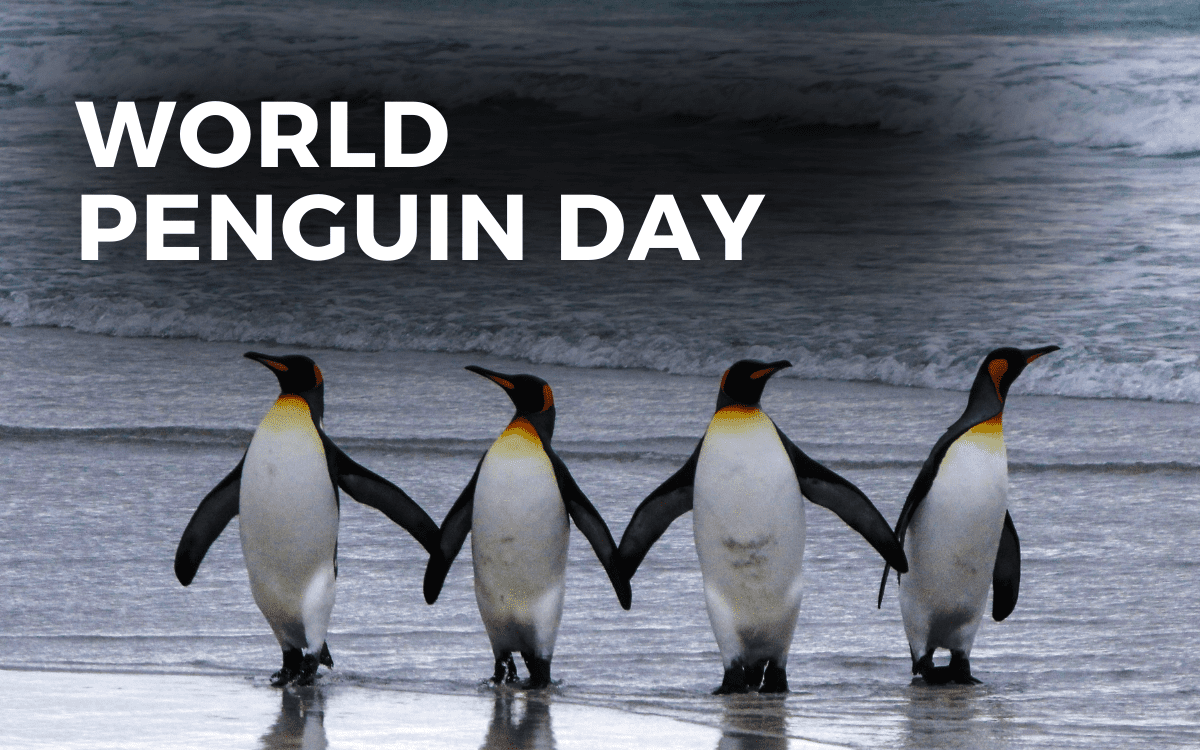Welcome to World Penguin Day. Every April 25th, we celebrate these amazing creatures and their incredible journeys through the icy waters of Antarctica. Penguins are some of nature’s most resilient birds—able to adapt and survive in extreme conditions. On this day, let us take a moment to appreciate all that they have endured throughout history while learning more about their unique characteristics, conservation efforts for them, threats facing them today as well as other holidays celebrating similar animals. From species types and interesting facts about penguins to resources for learning more about them – join us on our journey into the world of penguins on World Penguin Day.

What is World Penguin Day?
World Penguin Day is an annual celebration of the world’s penguin species. It was first established in 2008 by the United Nations Environment Programme (UNEP) to bring attention to the plight of these birds and their need for conservation. The day falls on April 25th each year, which marks the beginning of penguin breeding season in Antarctica.
History of World Penguin Day
The idea for World Penguin Day originated with a group of environmental activists who wanted to raise awareness about the threats facing penguins due to climate change, overfishing, and habitat loss. They proposed that April 25th be designated as a special day dedicated to celebrating these amazing creatures and raising awareness about their plight. In 2008, UNEP officially declared April 25th as World Penguin Day, and it has been celebrated ever since.
How To Celebrate World Penguin Day
World Penguin Day is a day to celebrate these amazing creatures and their unique characteristics while also learning more about the different types of penguins around the world. There are many ways you can celebrate this special day. Some ideas include:
- Learn more about different types of penguins or read up on their habitats and behavior.
- Take part in activities like making crafts featuring your favorite type of penguin or watching documentaries about them online.
- Host virtual events such as live streams with zookeepers or experts discussing the plight of penguins in our changing climate.
- If you have access to a beach or waterfront area near you, consider taking a trip there during this time so you can observe any local wildlife firsthand.
- Share photos or videos of penguins online, post facts about them, or simply spread awareness about their conservation needs.
World Penguin Day is an opportunity to learn more about these amazing creatures, their habitats, and how we can help protect them. No matter how you choose to celebrate it, Penguin Day provides a great way to show your appreciation for these beloved animals.
Hashtags for World Penguin Day
Using hashtags is a way people around the world come together on social media platforms like Twitter and Instagram when celebrating holidays like World Penguin Day. Popular hashtags include:
- #worldpenguinday
- #savethepenguins
- #penguinlove
- #protectourplanet
These hashtags help draw attention from other users who may not know much about these animals but want to join in on spreading awareness. Now let’s explore the many varieties of penguins that inhabit our planet.
For the complete list of holidays to celebrate on social media in April, visit angiegensler.com/april-holidays
Other Holidays Celebrating Birds
From birds of prey to waddling flightless birds, there are a variety of holidays celebrating our feathered friends.
National Bird Day is held each year on January 5th to raise awareness about the importance of bird conservation. It also encourages people to learn more about the birds around them and to appreciate their beauty, natural behavior, and value as a part of our environment. Participants are encouraged to take action to protect wild birds in their area through activities such as planting native plants that provide habitat for birds or creating an artificial nesting box.
International Migratory Bird Day (IMBD) is an annual holiday celebrated on the second Saturday in May. It was created to raise awareness of migratory birds and their habitats, as well as to promote conservation efforts for these species. IMBD activities include bird-watching events, educational programs, art projects, and other initiatives that help people learn about the importance of protecting migratory birds. This day also serves as a reminder of how human activities can affect bird populations both positively and negatively.
The Great Backyard Bird Count (GBBC) takes place over four days each February when people all over the world take part in counting birds they see near them, or anywhere else they go outdoors during this time period. The GBBC helps researchers track changes in bird populations across North America while providing valuable data for conservation efforts worldwide. Participants are encouraged to upload photos or videos along with their observations so others can enjoy seeing what types of birds were spotted.
To learn more about the specific species known as penguins, let’s explore some resources for learning more about them in the next section.
For more holidays, download our free calendar with over 1,000 fun and unique holidays to celebrate this year. Head to angiegensler.com/holiday-calendar to grab your free copy!
Types of Penguins
Penguins are one of the most iconic and beloved animals in the world. They’re also incredibly diverse, with seven distinct species that inhabit different regions around the globe. Let’s take a look at each type of penguin and what makes them unique.
Emperor Penguins
These large birds can grow up to four feet tall and weigh up to 90 pounds. Emperor penguins live exclusively in Antarctica, where they breed during the coldest months of winter. They form huge colonies on sea ice near their breeding grounds, which can number into the thousands or even millions. Emperor penguins feed mainly on krill and fish found beneath Antarctic waters.
Adelie Penguins
Adelie penguins are smaller than emperor penguins but still impressive – they stand about two feet tall when fully grown. Like emperor penguins, adelies live only in Antarctica but tend to stay closer to land than their larger cousins do. Their diet consists mostly of krill, small fish, squid, and other marine life found near shorelines or shallow waters.
Chinstrap Penguins
Chinstraps get their name from a thin black line running across their face just below their eyes – it looks like they’re wearing an invisible helmet strap. These medium-sized birds measure between 20-30 inches long when fully grown and weigh up to 8 pounds. Chinstraps inhabit many islands along the Antarctic Peninsula as well as some areas off South America’s southern coast, such as Tierra del Fuego (the “Land of Fire”). They feed primarily on krill but will also eat small fish if available.
Gentoo Penguins
Gentoos are easily recognizable by their bright orange beaks and white patches above each eye that resemble spectacles. These medium-sized birds measure between 25-35 inches long when fully grown and weigh up to 10 pounds. Gentoos live primarily along Antarctica’s western coastline but have been known to venture further north towards New Zealand’s subantarctic islands during certain times of year for food or breeding purposes. Their diet consists mainly of krill supplemented with shrimp, squid, crustaceans, mollusks & other small aquatic creatures found nearby shores or shallow waters.
Macaroni Penguins
Macaronis get their name from an old English term used for someone who dresses extravagantly – these birds have yellow crests atop both sides of their head that make them look quite dapper indeed. Macaronis measure between 24-32 inches long when fully grown & weigh up to 7 pounds. They’re native only to Subantarctic Islands located in the south & east Australia/New Zealand region, including Crozet Island & Kerguelen Island. The macaroni diet is composed mainly krill supplemented by various types crustaceans & mollusks depending upon availability seasonally within local habitats.
Rockhopper Penguins
Rockhoppers may not be very big (they reach 18-24 inches long), but they sure know how to rock out – literally – thanks to tufts and spiky feathers atop their heads that give them the appearance of having wild hair. Rockhoppers inhabit numerous islands throughout the Southern Atlantic Ocean. Their diets consist mostly of shrimp supplemented by a variety of invertebrates found along rocky coasts surrounding inhabited areas.
King Penguins
King Penguins are the second largest species, standing 3 ft tall and weighing 30 lbs at full maturity. Unlike all other types mentioned so far, King Penguins live exclusively in the subantarctic island chain stretching from South Georgia to the Sandwich Islands in the Indian Ocean. Kings consume a variety of prey items, including squid, anchovies, herring larvae, and plankton. However, their primary dietary staple remains the same throughout their range – namely Krill, which forms the bulk of sustenance consumed annually.
Penguins come in a variety of shapes and sizes, each with its own unique characteristics. From the Emperor Penguin to the Macaroni Penguin, it’s no wonder that they are so beloved around the world. Now let’s explore some interesting facts about these amazing creatures.
Interesting Facts About Penguins
Penguins are fascinating creatures that have adapted to live in some of the harshest climates on Earth. They have evolved unique behaviors and physical characteristics to survive in their environment, making them an interesting species to study.
Diet and Feeding Habits of Penguins
Penguins feed mainly on krill, fish, squid, and other small marine animals. To hunt for food, they use their wings as flippers underwater while swimming at speeds up to 15 miles per hour. During breeding season, penguins can dive up to 800 feet deep looking for food.
Breeding Habits of Penguins
Most penguin species breed during the summer months when there is plenty of food available. The male will build a nest out of stones or grasses and then wait for a female mate who will lay one or two eggs, depending on the species. Both parents take turns incubating the eggs until they hatch after about 35 days. After hatching, both parents share responsibility for feeding and caring for the chicks until they fledge (leave) the nest after 2-3 months old.
Penguins are fascinating creatures, and learning about their diet, breeding habits, and migration patterns can provide us with a better understanding of the threats they face in our ever-changing world. From climate change to overfishing and habitat loss, let’s take a closer look at the various threats that penguin populations are facing today.
Threats to Penguin Populations
Climate Change and Sea Level Rise
Climate change is one of the most serious threats to penguin populations. As temperatures rise, sea ice melts, which affects the availability of food for many species of penguins. Penguins rely on krill and fish as their primary source of food, but when the sea ice melts, it reduces their access to these resources. Additionally, rising sea levels can cause flooding in coastal areas where some species of penguins breed and nest. This can lead to a decrease in breeding success or even displacement from traditional nesting grounds.
Pollution and Oil Spills
Pollution is another major threat to penguin populations around the world. The accumulation of plastic debris in our oceans has caused an increase in mortality rates among seabirds like penguins due to ingestion or entanglement with marine debris such as fishing nets or plastic bags.
In addition, oil spills are a major concern for all aquatic wildlife, including penguins, because they are highly sensitive to petroleum-based products that may be released into their environment during an oil spill event. Oil spills can have devastating effects on birds by causing skin irritation and other health problems related to exposure to toxic chemicals found in crude oil products, such as benzene and polycyclic aromatic hydrocarbons (PAHs).
Though the threats to penguin populations are real and urgent, conservation efforts such as international laws, research programs, and education campaigns have been implemented in order to protect these beloved birds. Let’s now take a look at some of the ways that humans are actively working to preserve their habitats.
Conservation Efforts for Penguins
Penguin populations are threatened by a variety of human activities. Conservation efforts for penguins have been underway for decades and involve international laws and regulations, research and monitoring programs, as well as education and awareness campaigns.
International Laws and Regulations
International agreements like the Antarctic Treaty System (ATS) protect Antarctica from exploitation while also promoting scientific cooperation in this region. The ATS has several protocols that regulate fishing activities in Antarctic waters to ensure sustainable management of marine resources. Additionally, other countries have signed treaties to protect species like emperor penguins which are listed in Appendix I of the Convention on International Trade in Endangered Species (CITES). This treaty prohibits commercial trade of these species without special permits issued by governments.
Research and Monitoring Programs
Research is essential for understanding how climate change affects penguin populations or how different fisheries impact their food sources. Scientists collect data through field studies or satellite imagery to monitor changes over time or detect new threats before they become too severe. For example, researchers use drones with thermal cameras to count Adelie penguin colonies at remote locations in Antarctica where it’s difficult to access them otherwise. This information helps inform conservation strategies tailored specifically for each population’s needs.
With the help of conservation efforts, we can ensure that penguins remain safe for generations to come. To further celebrate our feathered friends, let’s explore some other holidays dedicated to birds.
Resources for Learning More About Penguins
Penguins are fascinating creatures, and there is a lot to learn about them. If you’re looking for resources on penguin biology, ecology, and conservation, here are some great books and websites to check out.
Books on Penguin Biology, Ecology, and Conservation
There are many excellent books available that provide detailed information about penguins. Some of the best include:
- “The Penguins: Natural History & Conservation” by David Ainley and Paul Ponganis
- “Penguins: A Complete Guide to Their Biology & Behavior” by Dr. Wayne Lynch
- “The Penguin Encyclopedia” edited by Drs. Tony Martin-Jones and John Sparks
- “Penguin Science & Conservation” edited by Lloyd Spencer Davis
- “A Field Guide to the Penguins of Antarctica” by Bill Fraser
Websites Dedicated to the Study of Penguins
For those who prefer digital resources over physical ones, there are plenty of websites dedicated solely to studying penguins in depth. The World Wildlife Fund (WWF) has an extensive section devoted specifically to these amazing birds, with information ranging from their habitats all the way through threats they face today due to climate change or human activity such as oil spills or overfishing. Additionally, sites like PenguinWorld have comprehensive databases full of facts about different species as well as educational materials for teachers or students interested in learning more about them.
Finally, if you want your research efforts to go beyond just reading up on these animals but actually making a difference in their lives, then consider supporting one of the many organizations working hard towards protecting penguin populations around the world. Organizations like Sea Shepherd Global use direct action tactics, while others like Antarctic Oceans Alliance focus more on advocacy work – both doing important work that needs our support.
Conclusion
World Penguin Day is a great opportunity to learn more about these amazing creatures and how we can help protect them. Penguins are an important part of our world, and it’s up to us to ensure their populations remain healthy for future generations. By understanding the threats they face, supporting conservation efforts, and celebrating World Penguin Day each year, we can all do our part in protecting this species. So take some time today to appreciate penguins on World Penguin Day – you won’t regret it.
















